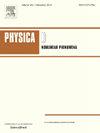Biological aggregations from spatial memory and nonlocal advection
IF 2.7
3区 数学
Q1 MATHEMATICS, APPLIED
引用次数: 0
Abstract
We investigate a nonlocal reaction–diffusion–advection model of a population of organisms that integrates spatial memory of previously visited locations and nonlocal detection in space, resulting in a coupled PDE–ODE system reflective of several models found in spatial ecology. Our study advances the mathematical understanding of such models by proving the existence and uniqueness of a global weak solution in one spatial dimension using an iterative approach. This result includes potentially discontinuous detection kernels, explicitly emphasizing the so-called ‘top-hat’ detection function, and does not place any restriction on the rate of advection, thereby addressing some analytical voids in the mathematical discourse on such models. A comprehensive spectral and stability analysis is also performed, providing analytical expressions for bifurcation values contingent on various model parameters, such as species advection rate, diffusion rate, memory uptake and decay rates. Unlike classical reaction–diffusion systems, the point spectrum may now include elements that have an infinite-dimensional kernel. We show the existence of such a point and that it remains negative, ensuring that it does not influence the stability of the constant steady state. Linear stability analysis then provides critical values for destabilizing the constant steady state. We explicitly describe the form of the non-constant steady state near these critical values and classify the nature of the pitchfork bifurcation as forward/backward and stable/unstable. To complement our analytical insights, we explore a targeted case study of three particular instances with the top-hat detection function. Using a pseudo-spectral method, we depict a numerical bifurcation diagram showing cases with sub or supercritical behaviour.
来自空间记忆和非局部平流的生物聚集
我们研究了生物种群的非局部反应-扩散-平流模型,该模型集成了先前访问位置的空间记忆和空间中的非局部检测,从而形成了一个耦合的PDE-ODE系统,反映了空间生态学中发现的几种模型。我们的研究通过使用迭代方法证明了在一个空间维度上全局弱解的存在性和唯一性,从而提高了对这些模型的数学理解。该结果包括潜在的不连续检测核,明确强调所谓的“顶帽”检测函数,并且没有对平流速率施加任何限制,从而解决了此类模型的数学论述中的一些分析空白。还进行了全面的光谱和稳定性分析,提供了随各种模型参数(如物种平流率、扩散率、记忆吸收率和衰减率)变化的分岔值的解析表达式。与经典的反应扩散系统不同,点谱现在可能包括具有无限维核的元素。我们证明了这样一个点的存在性,并且它仍然是负的,确保它不影响恒稳态的稳定性。然后,线性稳定性分析提供了使恒定稳态不稳定的临界值。我们明确地描述了这些临界值附近的非恒定稳态的形式,并将干草叉分叉的性质分为向前/向后和稳定/不稳定。为了补充我们的分析见解,我们探索了三个具有顶帽检测功能的特定实例的目标案例研究。利用伪谱方法,我们描绘了一个数值分岔图,显示了具有亚临界或超临界行为的情况。
本文章由计算机程序翻译,如有差异,请以英文原文为准。
求助全文
约1分钟内获得全文
求助全文
来源期刊

Physica D: Nonlinear Phenomena
物理-物理:数学物理
CiteScore
7.30
自引率
7.50%
发文量
213
审稿时长
65 days
期刊介绍:
Physica D (Nonlinear Phenomena) publishes research and review articles reporting on experimental and theoretical works, techniques and ideas that advance the understanding of nonlinear phenomena. Topics encompass wave motion in physical, chemical and biological systems; physical or biological phenomena governed by nonlinear field equations, including hydrodynamics and turbulence; pattern formation and cooperative phenomena; instability, bifurcations, chaos, and space-time disorder; integrable/Hamiltonian systems; asymptotic analysis and, more generally, mathematical methods for nonlinear systems.
 求助内容:
求助内容: 应助结果提醒方式:
应助结果提醒方式:


